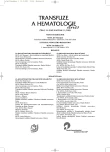Blood donors satisfaction survey – public injury
Authors:
J. Mertová; A. Lerlová; Z. Gašová; M. Böhmová; K. Želiszewská
Authors‘ workplace:
Ústav hematologie a krevní transfuze, aferetické oddělení
Published in:
Transfuze Hematol. dnes,11, 2005, No. 3, p. 122-124.
Category:
Comprehensive Reports, Original Papers, Case Reports
Overview
Blood donation is still of essential role in modern times. We performed anonymous blood donor questionnaire which content was divided into four thematic parts. First part dealt with basic characteristics of blood donors, second with proper blood donation, third with our transfusion department operations, and donor’s comments and ideas were discussed in the fourth part. We divided blood donors according to the type of blood collection into groups of whole blood donation and both plasmapheresis as well as thrombocytopheresis. On the basis of questionnaire, we found more information on our blood donors, theirs motivation to donate blood, as well as theirs opinions of our transfusion department operation. The questionnaire contributed to the fact, that it is necessary to promote blood donation mostly among young generation. Further, people are not very familiar with blood donation using automated devices, therefore it is necessary to discuss this issue. Anonymous inquiry revealed some information on blood donors and showed which trends we should follow to improve our work.
Key words:
blood donation, blood donors, plasma donors, thrombocyte donors, thrombocytopheresis, plasmapheresis
Labels
Haematology Internal medicine Clinical oncologyArticle was published in
Transfusion and Haematology Today

2005 Issue 3
Most read in this issue
- Hereditary hemochromatosis
- Benefit of the different sensitivity of aPTT reagent for diagnosis of lupus anticoagulant inhibitor
- LDL apheresis – evaluation of the results from 1000 performed procedures
- Detection of minimal residual disease in acute lymphoblastic leukemia using quantification of immunoglobulin and T-cell receptor genes rearrangements. How to avoid misinterpretation of the results
